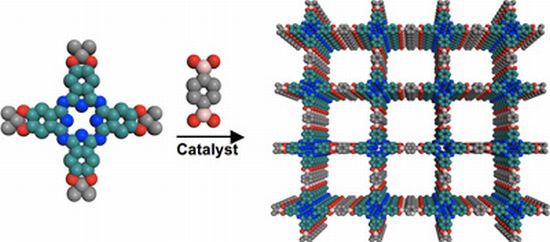
Eco Factor: Molecular framework developed for economical, flexible solar cells.
The Dichtel group in the Department of Chemistry and Chemical Biology at Cornell University has developed a method to organize organic dyes into stacked, porous 2D sheets, which can later be incorporated into flexible solar cells.
The process employs organic dye molecules assembled into a structure known as a covalent organic framework (COF). The strategy uses a simple acid catalyst and relatively stable molecules called protected catechols to assemble key molecules into a neatly ordered 2D sheet. These sheets can be stacked on top of one another to form a lattice that provides pathways for charge to move through the material.
The best part of the process is that the reaction is reversible, so any errors that occur can be undone and corrected. At the core of the framework are molecules called phthalocyanines, a class of common industrial dyes used in products from blue jeans to ink pens. Phthalocyanines are also closely related in structure to chlorophyll, which absorbs almost the entire solar spectrum.
The structure by itself is not a solar cell yet, but it is a model that can significantly broaden the scope of materials that can be used in COFs. Once the framework is assembled, the pores between the molecular latticework could potentially be filled with another organic material to form light, flexible, highly efficient and easy-to-manufacture solar cells.
Via: Physorg




